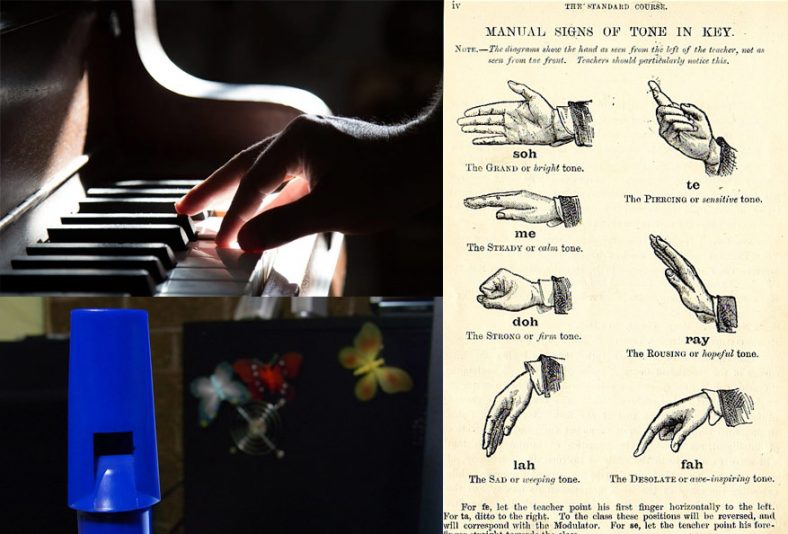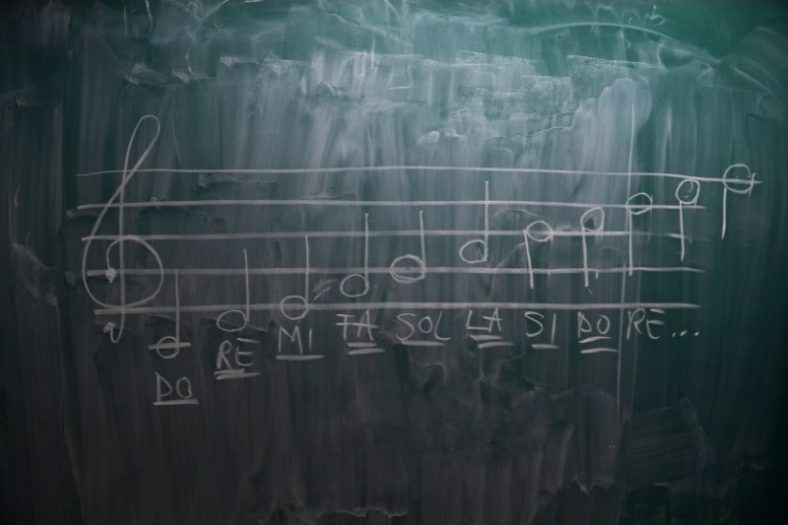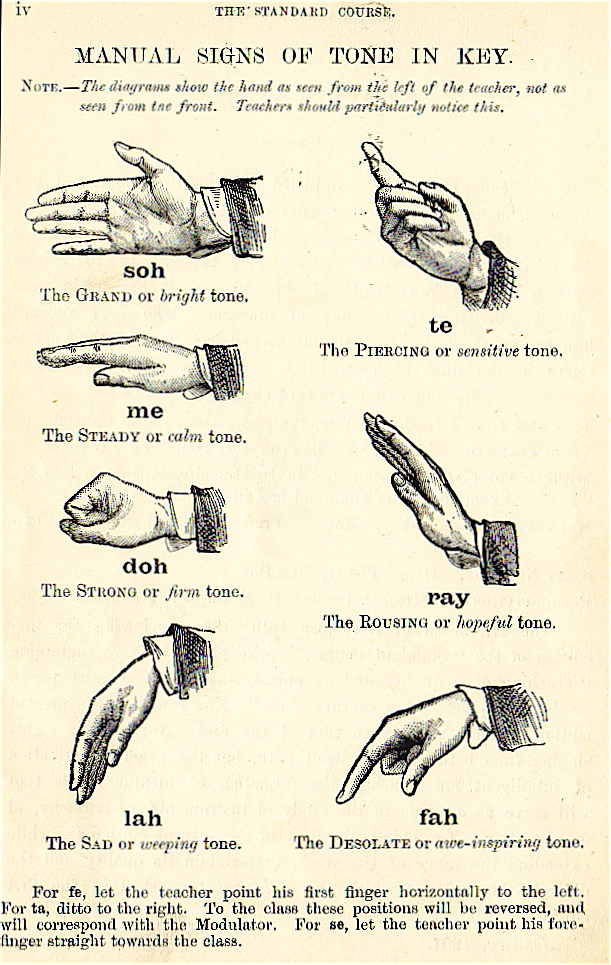Solfege (What is it, Hand Signs, Benefits) – Do, Re, Me

“Solfege” (English/French) or Solfeggio (Italian) is a simple system to learn basic concepts of music. Solfege teaches you how to hear, sing, and write harmonies and melodies.
Solfege is still in use for sight-reading training today, despite its long history. It is still an essential component of music education.
In this post, we will explain how each system works in any given musical situation, its pros and cons, various hand signs, and the benefits of having Solfege as a part of your musical arsenal.
Contents
What is Solfege?
Solfege, also known as Solfa or Solfeggio is a music education system used to teach aural skills, pitch, and sight-reading primarily in Western music.
There are seven syllables in the Solfege system corresponding to the seven notes of the musical scale.
These are Do, Re, Mi, Fa, So, La, and Ti which correlate with C, D, E, F, G, A, and B respectively.
This approach has a huge advantage since the syllables are easier to sing than letters.
A really good exercise would be to sing the Solfege while playing the C major scale on the piano. According to this system, the C would be sung as Do, the D as Re, and so on.
This system works not only for the major scale but for almost all the non-traditional scales too. While it takes some practice to get comfortable with, Solfege allows musicians to decipher the pitches of a relatively new piece of music with ease.
History and Origin of Solfege
I’ll preface this section by noting that there are numerous theories about the origin of the Solfege system.
The most popular one suggests that an Italian composer Guido of Arezzo invented it to name the six notes of the hexachord.
For this naming system, he used the first syllable of each line of the famous Latin hymn Ut queant laxis. The first syllable was called Ut until the 1600s after which it was changed to Do upon the recommendation of musicologist Giovanni Battista Doni. One more syllable, Si was added to complete the diatonic scale.
Si was later changed to Ti in the 19th century by Sarah Glover. This was done to ensure that every syllable starts from a different letter. An alternative theory suggests that these syllables originated from other Eastern music cultures such as swara, durar mufassalat, and Jianpu.
The Forms of Solfege

The Solfege system has two different forms, Moveable Do and Fixed Do.
Both these systems have their own advantages and disadvantages.
1. Moveable Do
Moveable Do, as the name suggests is a type of Solfege system in which the Do moves around according to the tonic center (key) of the piece of music.
For example, if we’re in the key of C major, then Do will correspond to C whereas, in the key of G major, it will correspond to G.
The syllable Do will always be the first degree of the key. Thus, it is important to note that in Moveable Do, a certain tune will always be sung with the same syllables (Do, Re, Mi, Fa, etc.) regardless of the key. Another huge advantage of the Moveable Do system is that it is universal across all keys.
Hence, it is not mandatory to know the key of the music beforehand.
For example, if we hear a tune that goes “do re mi do re mi fa” we can immediately put that in any key we want.
In the 19th century, Sarah Ann Glover invented the Tonic Sol-Fa, which is an important variant of the Moveable Do but differs in some aspects from the traditional system.
The traditional system of Moveable Do helps immensely in the theoretical understanding of music.
This is because the tonic is established first and then the syllables are associated with the notes according to the key of the song.
Since it is a moveable system, the key is always given at the start of the song.
While this system is great for major keys, we hit a wall when it comes to using Solfege to write melodies for minor keys.
This is because the Solfege system began primarily as a purely diatonic system for singing modal melodies around a fixed tonic.
However, there is a way to add chromaticism in Solfege too. According to this system, we can raise or lower the pitch of the note by a semitone by changing the vowel in the syllable. Thus, all the “ah” sounds were changed to “ay” sounds when lowered by a semitone and changed to “ee” sounds when raised.
For example, if we are in the key of C minor, we would sing “me” for Eb instead of “mi” (for E in C major).
There are two methods to learn the Moveable Do system in a minor key:
A. Using the Do as the tonic
In this system, the Do does not change while switching from a melody in a major key to its parallel minor key. For example, while switching from C major to C minor, C remains Do and we use Me, Le, and Te for the minor 3rd, minor 6th, and minor 7th respectively.
One of the biggest advantages of this system is that the Do is preserved as the tonic even after switching to a minor key.
B. Using the La as the tonic
This system considers the minor key in consideration to be the relative minor of a corresponding major key. Thus, La is used as the tonic note in the minor. A lot of classical melodies quickly modulate to the relative major key and that is where this system is the most useful.
However, there are a few cons to this system. It does not allow the singer to appreciate the minor mode on an equal basis with the major.
The Moveable system is more suited for musical theorists and composers while the Fixed Do system is more applicable to instrumentalists.
This is because the Moveable system requires students to infer melodic and choral implications on the basis of their singing. The Moveable Do system is used most commonly in the United States and Canada, although it is also found in certain conservatories in other countries.
2. Fixed Do System
In this system, as the name suggests, each note has a syllable associated with it irrespective of the key of the song.
For example, C will always be sung as Do, D as Re, E as Mi, and so on, even if the key of the song is F major, Ab minor, or any other one for that matter.
There have been a lot of controversies about system works better in conservatories in the United States.
While Moveable Do is definitely the easier of the two, a lot of teachers think that the Fixed Do helps develop stronger sight-reading and ear training skills.
The emphasis is on the relationships between specific pitches rather than the function of intervals within melodic lines and chord progressions.
In choir sight-singing, the Fixed Do system is better suited for reading atonal music, polytonal music, or any piece of music that modulates the key often.
A performer may find it difficult to play music written for transposing instruments.
This happens when the concert pitch note to be played differs from the note written in the sheet. In these cases, the musician may experience cognitive dissonance as they will be reading one note and playing another.
In comparison to this, the Moveable Do system relies on the relative pitch while the Fixed Do system relies on the absolute pitch.
The latter is more beneficial for musicians aiming to attain absolute perfect pitch while the other one is more versatile and has practical advantages in musical applications.
Solfege Hand Signs

The idea of using hand signs is pretty simple. Each sign corresponds to a tone of the 7-note solfege system
A singer will keep one hand free and make the signs with his/her hand placed near the sternum as they sing the note.
Beginners start with the major scale and either hand can be used to make the sign. After you learn to do it fluently while singing the major scale up and down, you can gradually increase the complexity with three-note arpeggios.
These hand signs were developed by John Curwen, which is why they are also referred to as the Curwen hand signs. They became popular in the late 1940s and 50s as a part of Zoltan Kodaly’s ‘Kodaly concept or method’ in Europe.
Benefits of Solfege

Solfege is an aural musical language that helps musicians to write down the melodies they hear, thereby making it more efficient for skills like pitch recognition, sight-singing, and sight-reading.
The Hungarian Kodaly method is the most notable one in the study of Solfege.
While learning Solfege, the ears are constantly being trained to recognize some of the most common patterns in music. It takes a lot of practice to get comfortable with this system, but after some familiarity, it becomes extremely easy to decipher intervals and chords by merely hearing the Solfege syllables.
The Solfege system also helps break down melodies into smaller pieces and provides a frame of reference while learning new music. The Solfege system helps to understand a certain piece of music with very little information.
For example, if the musician recognizes two notes as Do going up to Fa, they can easily deduce the following points about the piece of music:
• The pitch movement is from scale degree I to IV
• This movement is from the tonic to the subdominant
• The interval is a perfect fourth
It is possible to know all this from merely two notes because Moveable Do assigns Do to the tonic key of the melody. So, if one heard the Do going up to the Fa, then one can easily ascertain the aforementioned points.
Summary
Solfege is a great way for musicians to learn. The system uses hand signs for each tone in major and minor scales.
They became popular in the late 1940s and 50s as a part of Zoltan Kodaly’s ‘Kodaly concept or method’ in Europe. Solfege is an aural musical language that helps musicians to write down the melodies they hear, thereby making it more efficient for skills like pitch recognition, sight-singing, and sight-reading.
While learning Solfege, the ears are constantly being trained to recognize some of the most common patterns in music. It takes a lot of practice to get comfortable with this system, but after some familiarity, it becomes extremely easy to decipher intervals and chords by merely hearing the Solfege syllables.
The Solfege system also helps break down melodies into smaller pieces and provides a frame of reference while learning new music. The Solfege system helps to understand a certain piece of music with very little information.
Featured image: “Tin Whistle” by tolomea is licensed under CC BY 2.0





